Archive
Building Communities: The Schermerhorn
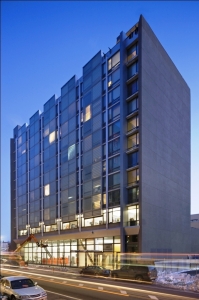 Located at the crossroads of Brooklyn, The Schermerhorn — a 21st century twist on affordable housing — is a joint project of The Actors Fund in conjunction with Common Ground (who oversees the building’s operations) and CUCS (Center for Urban Community Services, which takes care of the social services for the special needs tenants). And because the three agencies work together, all of the policies come from an amazing collaboration, and represent the best of what they can do.
Located at the crossroads of Brooklyn, The Schermerhorn — a 21st century twist on affordable housing — is a joint project of The Actors Fund in conjunction with Common Ground (who oversees the building’s operations) and CUCS (Center for Urban Community Services, which takes care of the social services for the special needs tenants). And because the three agencies work together, all of the policies come from an amazing collaboration, and represent the best of what they can do.
At first glance, The Schermerhorn’s architecture — created by Ennead Architects — is unusual for affordable housing, sporting a steel and glass façade constructed in a style more commonly used in luxury buildings. In a New York Magazine review of The Nehmiah Spring Creek Homes in East New York and The Schermerhorn, architecture critic Justin Davidson praised the design’s departure from the accepted norm: “Both these versions of affordable housing reject the utopian visions that once fueled modernists’ social zeal and scarred our cities with towers for the poor. Instead, in their quiet, pragmatic way, they prove what the marriage of philanthropy and government can achieve and demonstrate that pinched budgets need not translate into poverty of imagination.”
The Schermerhorn’s mission is not only to provide affordable housing and social services for those in need, it’s also providing low-cost performance and rehearsal space for local artists. As part of his job as The Actors Fund’s Activities Manager at The Schermerhorn, Matthew Brookshire develops opportunities for the tenants to build a community within the building, and to integrate the building with the neighborhood surrounding it.
“We’re also bringing The Actors Fund to Brooklyn,” says Matthew, who has worked as a performer, director and stage manager. “We’re its ambassadors. Not only do we want to provide affordable housing to help artists succeed, we strive to be good neighbors, and to promote all the services of The Fund.”
Having received funding from the Department of Cultural Affairs, creating affordable space for community arts groups was one of The Schermerhorn’s top priorities. From the project’s outset, the main, glass-walled street-level retail space was intended for a not-for-profit arts tenant. That turned out to be the Brooklyn Ballet, which is transforming the open space into its office, school and rehearsal studio. The glass wall has also enabled a sort of educational dialogue within the community, as passersby often stop to enjoy the beauty of dance.
“The interactive quality of the space has contributed to changing the overall feel of Schermerhorn Street,” says Matthew. “This light and transparency — it was done on purpose.”
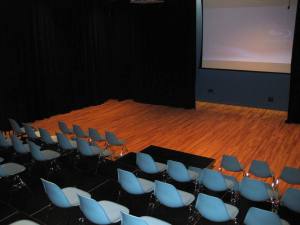 Also on street level is The Schermerhorn’s performance space, a clean, flexible black box that, depending on configuration, holds up to 200 people (though its primary set-up is better for a crowd of 100). Perfect for film screenings, dance, theatrical performances and special events, The Actors Fund is working to make the venue attractive and affordable to the Brooklyn performing arts community.
Also on street level is The Schermerhorn’s performance space, a clean, flexible black box that, depending on configuration, holds up to 200 people (though its primary set-up is better for a crowd of 100). Perfect for film screenings, dance, theatrical performances and special events, The Actors Fund is working to make the venue attractive and affordable to the Brooklyn performing arts community.
The feeling of community visible to everyone at street level continues upstairs to the building’s 216 studio apartments. Currently, there are 50 artist tenants — there will eventually be 100 — and 116 with special needs, the majority of which are formerly homeless, mentally ill or living with HIV-AIDS. The residential floors are an extension of the ground level’s forward-thinking design. Filled with angles, the hallways are anything but institutional. And while the small but bright and intelligently-appointed single-occupancy studios are admittedly not for everyone in the arts community, they are perfect for someone at a certain point in their career, whether it’s when they’re emerging, in transition, or retiring.
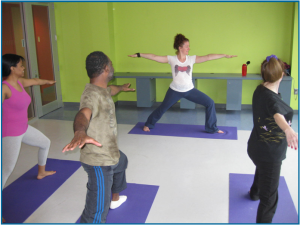 In addition to the building’s affordable rent, the artist tenants can use the ground floor theater for rehearsals and performances (“I love to see the tenants down here rehearsing, making the most of this amazing resource,” says Matthew) and utilize the building’s on-site social services. They can also take advantage of the building’s other amenities, which include health and wellness activities such as free yoga and acupuncture. There’s also a gym, computer lab, common room and spacious terrace, where a tenant “green thumb club” plans to tend an herb garden this spring.
In addition to the building’s affordable rent, the artist tenants can use the ground floor theater for rehearsals and performances (“I love to see the tenants down here rehearsing, making the most of this amazing resource,” says Matthew) and utilize the building’s on-site social services. They can also take advantage of the building’s other amenities, which include health and wellness activities such as free yoga and acupuncture. There’s also a gym, computer lab, common room and spacious terrace, where a tenant “green thumb club” plans to tend an herb garden this spring.
All of the tenants are encouraged to take part in a variety of group activities, many of which are arranged by Activities Coordinator Andrew Miller. There’s a monthly cooking class (followed the next week by a gathering in which the students prepare a meal for the other residents), a film series featuring movies chosen by tenants (Andrew comes from the film world, so he encourages uniquely inspired choices), dog walking excursions to the Williamsburg BARC shelter and volunteer opportunities in the soup kitchen and pantry at St. John’s Bread & Life Program in Bedford-Stuyvesant. 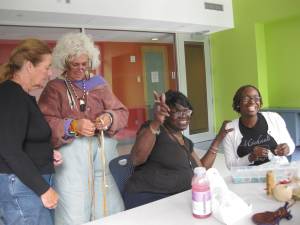 There are other activities as well, from in-house gatherings to field trips. The activities attract participation from throughout the building, creating a wonderful dialogue between the arts and special needs tenants, who are constantly learning and growing from interacting with each other.
There are other activities as well, from in-house gatherings to field trips. The activities attract participation from throughout the building, creating a wonderful dialogue between the arts and special needs tenants, who are constantly learning and growing from interacting with each other.
“It’s a very exciting and sometimes quite challenging place to work,” says Matthew. “I’m lucky to work with a lot of dedicated people whose hearts are in the right place.”
But as challenging as it sometimes may be, the community they are working to build is a beautiful one, a snapshot of which was taken by photographer Michele Asselin’s “The Schermerhorn: Summer 2010.” The portrait project is a permanent installation in the offices, and consists of over 60 stunning black-and-white photographs of residents and staff.
“The face of downtown Brooklyn is changing,” says Matthew. “This is affordable housing that’s beautiful yet accessible. And it enables artists to stay in New York and focus on pursuing their careers.”
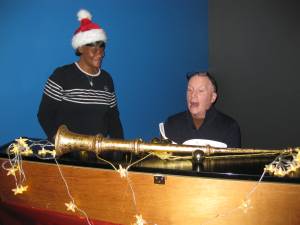 Even though The Schermerhorn hasn’t been open for very long, it’s already changed people’s lives. And Matthew isn’t immune to the positive forces at work in the building, either.
Even though The Schermerhorn hasn’t been open for very long, it’s already changed people’s lives. And Matthew isn’t immune to the positive forces at work in the building, either.
“For me, I feel such a different connection to the city than when I was only performing or working backstage. I was looking for a way to focus my energy outward, and now I feel a different relationship with my community just walking down the street. I’m surprised every day.”
The Schermerhorn is currently accepting applications for residency. Visit The Actors Fund website for more information on how to apply.
–Karissa Krenz
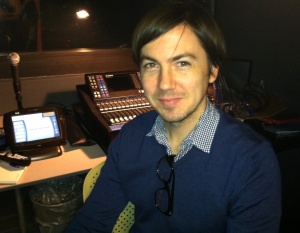

You must be logged in to post a comment.